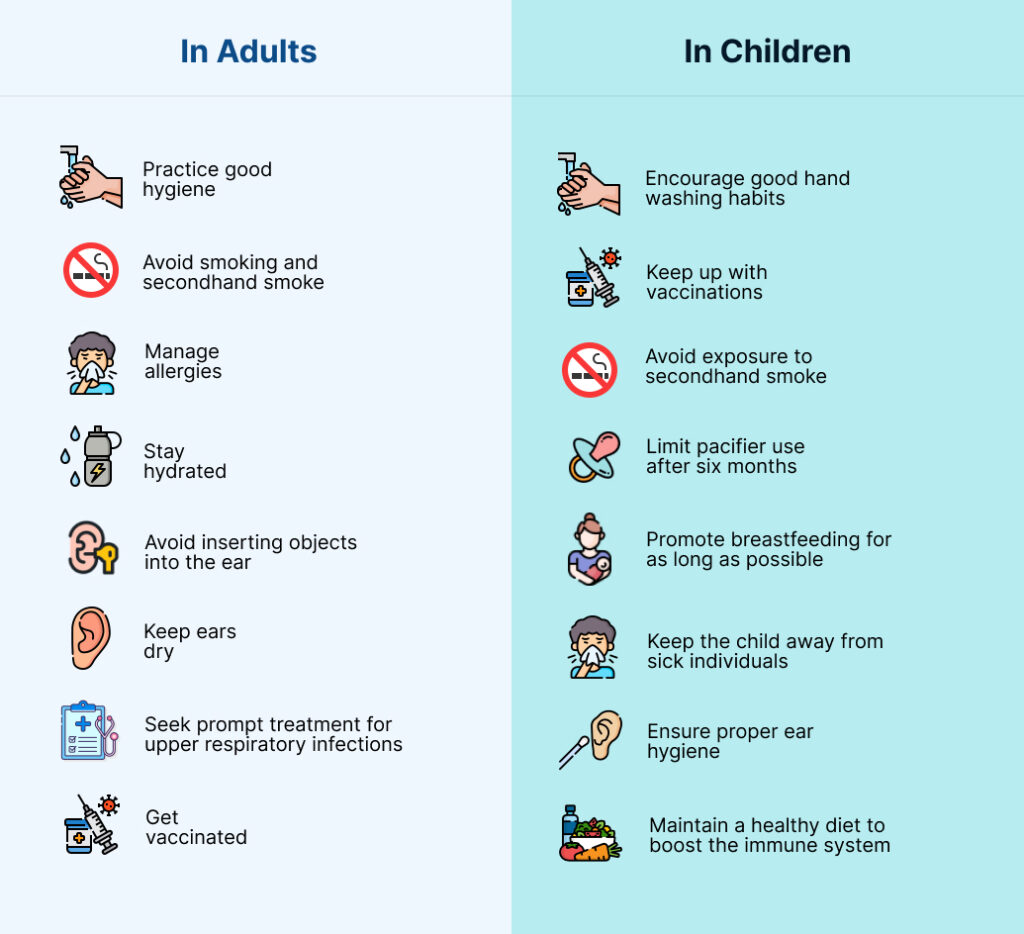
Ear infections are common, especially in kids. But there are a lot of myths about whether they can be passed from person to person. If you’ve had an ear infection, it likely came after a cold, fever, or respiratory issue, leaving you with ear pain, trouble sleeping, or fluid draining from your ear.
So, are ear infections contagious? The short answer is no—they don’t spread from one person to another!
In this blog, we’ll cover everything about ear infections, whether they are contagious, their causes, symptoms, and treatment.
What Is an Ear Infection, Exactly
An ear infection, also called acute otitis media, develops in the middle ear. It is basically the space behind the eardrum with tiny bones for hearing. When the Eustachian tube gets blocked, fluid builds up and causes trouble hearing. After fluid becomes infectious, it leads to symptoms like ear pain and pressure.
| Eustachian tubes are narrow tubes that run from the middle ear to high in the back of the throat. |

Are Ear Infections Contagious? Explained
No, ear infections aren’t contagious. Even if you’re wondering, "Are ear infections contagious in adults or can you get an ear infection from someone else?" The answer remains the same.
Ear infections happen when fluid gets trapped behind the eardrum, giving bacteria or viruses a place to grow. This often results from colds, sinus infections, respiratory issues, or allergies. Germs can also enter through water in pools or baths. Symptoms may show up in 2 to 7 days. Simply put, you can’t catch an ear infection from someone unless you catch the underlying illness, like a cold.
For instance, a person gets a cold and it spreads through sneezing, coughing, or close contact. Nonetheless, the ear infection will not spread itself as it is a complication of the cold and cannot be passed on.
How Long Are You Contagious With an Ear Infection?
As already said, ear infections are not contagious. However, the germs or viruses that can lead to an ear infection, such as those that cause colds or respiratory infections, can be contagious.
This typically lasts for about 7 to 10 days, starting from when you first begin to show symptoms, like a runny nose, cough, or fever.
Are Ear Infections Contagious Through Headphones
No, ear infections are not directly contagious through headphones. However, certain hygiene-related factors could increase the infection risk.
How? Someone with an ear infection uses your headphones and leaves behind bacteria or fungi. These microorganisms transfer to another person using the same headphones especially if that person has small cuts, scratches, or irritation in their ear canal.
Now that we know why ear infections are called contagious and why they are not, let’s explore more about them.
Types of Ear Infection
It is generally divided into 3 major categories.
➡️ Acute Otitis Media (AOM)
AOM, or Acute Otitis Media, is the most common and least severe ear infection. The middle ear gets infected and swells, leading to fluid buildup behind the eardrum. A fever can also develop.
Recovery period: 3 to 7 days.
➡️ Otitis Media With Effusion (OME)
It is also known as serous otitis media or "glue ear". Once an ear infection is gone and you feel back to normal, there might be some fluid left in your ear. You might not notice any symptoms, but a doctor can find the remaining fluid for sure during an examination.
Recovery period: 4 to 6 weeks.
| OME is a frequent infection in kids. This is also the main reason many children experience hearing loss over time. Source: National Library of Medicine |
➡️ Chronic Otitis Media With Effusion (COME)
Some people may experience fluid building up in the middle ear repeatedly, even without an infection or cold. This can be a chronic ear infection and weaken the ability to fight off other infections. Besides this, it negatively affects hearing.
Recovery period: Without treatment, it lasts up to 3 to 6 months.
Is Swimmer’s Ear Contagious
Swimmer’s ear (otitis externa) is frequently thought of as a type of ear infection, but that’s not correct.
Swimmer’s ear affects the outer ear canal, whereas an ear infection usually happens in the middle ear. It isn't contagious. It typically occurs when bacteria or fungi build up in the outer ear canal, often caused by moisture left behind from activities like swimming, showering, or sweating. Similar to an ear infection, it can spread within the person's ear, but it can't be transferred to others through casual contact. Despite that, sharing items like earbuds, towels, or swim gear may transfer bacteria.
Causes & Symptoms of Ear Infections
When fluid and germs become trapped in the outer, inner, or middle ear, they can result in different kinds of ear infections with distinct symptoms.
| Outer Ear | Middle Ear | Inner Ear |
|---|---|---|
| Causes | ||
| ♦ Trapped moisture ♦ Injury to the ear canal ♦ Allergic reactions | ♦ Colds and respiratory infections ♦ Eustachian tube dysfunction ♦ Adenoid issues | ♦ Viral infections ♦ Bacterial infections ♦ Autoimmune conditions |
| Symptoms | ||
| ♦ Itching in the ear canal ♦ Redness inside the ear ♦ Swelling of the ear canal ♦ Pain or discomfort, especially when pulling on the ear ♦ Discharge or fluid leaking from the ear | ♦ Ear pain (sharp, sudden, or dull) ♦ Tugging or pulling at the ear (common in children) ♦ Fever ♦ Fluid drainage from the ear ♦ Difficulty hearing or muffled sounds ♦ Irritability or fussiness in children | ♦ Dizziness or vertigo (spinning sensation) ♦ Hearing loss or ringing in the ears (tinnitus) ♦ Nausea or vomiting |
Adults usually know what’s happening, but infants or children themselves cannot understand anything. This is why parents should learn about the reasons behind ear infections—so they can take proactive steps to prevent them in their kids.
Ear Infection in Children
What Parents Should Know about Ear Infections in Kids
Infants and young children between 3 months and 3 years are much more likely to develop ear infections compared to adults. However, if you ask ‘Are ear infections contagious in kids’? Then it is usually not.
In fact, most kids will have at least one ear infection due to these two major reasons:
➡️ Small Eustachian Tubes
Young children's tubes are shorter and narrower. As a result, it is more easy for the tube to get blocked. Additionally, their tubes are often positioned more horizontally, which makes it tough for fluid to drain.
➡️ Immune System Development
By around 6 months, babies start to lose some of their natural immunity. They also become more social. The germs and bacteria they exchange with others increase the risks of infection.
What’s More That Increases the Risk of Ear Infections in Kids
► Exposure to Smoke
Children exposed to secondhand smoke from cigarettes or other tobacco products have a higher risk of developing ear infections. Smoke can irritate the respiratory system and contribute to inflammation.
► Family History
A family history of ear infections can increase a child's risk. If siblings or parents have had recurrent ear infections, the child may be more prone to them as well.
► Daycare Attendance
Children who attend daycare or are in close contact with other children may have a higher risk of ear infections due to increased exposure to germs and viruses.
► Pacifier Use
Prolonged use of pacifiers, especially after six months of age, has been linked to an increased risk of ear infections, as they can affect the way children swallow and lead to fluid buildup in the ears.
► Poor Feeding Practices
Children who are bottle-fed while lying down or those who do not breastfeed may be at a higher risk for ear infections. Breastfeeding provides antibodies that help protect against infections.
Since you’ve learned the answer to “Are ear infections contagious?" What steps can you take to protect yourself from them?
How To Prevent Ear Infections

Treatment for Ear Infections
How To Make It Go Away!
Prevention can help stop infections, but what if one has already started? Many ear infections, especially in kids, often get better on their own without treatment. Doctors might suggest waiting a few days to see if the symptoms go away. If the infection gets worse, though, treatment will be needed.
Here are some ways to treat ear infections.
➡️ Antibiotics
Antibiotics are prescribed when the ear infection is caused by bacteria or if it doesn’t improve on its own. They are most commonly used for middle ear infections (otitis media), especially when:
- The symptoms are severe (high fever, intense pain).
- The infection lasts more than 2-3 days without improvement.
- There is fluid buildup behind the eardrum (which can impair hearing).
- The patient is an infant or toddler.
- The doctor may prescribe to use of Amoxicillin to get rid of the cold.
➡️ Decongestants, Antihistamines, or Nasal Steroids
They help manage symptoms of ear infections, especially when allergies or congestion are involved.
- Decongestants reduce swelling in the nasal passages and Eustachian tubes, which helps improve drainage and ease pressure.
- Antihistamines stop the effects of histamine, a chemical that causes allergy symptoms, and prevent fluid from building up in the ears.
- Nasal steroids reduce inflammation in the nasal passages and Eustachian tubes, providing long-term relief and keeping them clear.
- Although these medications don’t cure the infection directly, they help reduce symptoms, improve drainage, and support faster recovery.
➡️ Ear Tubes
Ear tubes, also known as tympanostomy tubes, are small tubes inserted into the eardrum to help manage ear infections. Children who experience multiple ear infections within a short period may benefit from ear tubes. The tubes allow fluid to drain from the middle ear, reducing the risk of future infections.
Ear Infection Treatment Cost
| Cost factor | Estimated cost range |
|---|---|
| General physician or ENT specialist visit | $100 to $300 |
| Antibiotics | $100 to $300 |
| Specialized care | $250 to $500 |
| Ear tube surgery | $1,000 to $4,000 |
| Hearing test | $50 to $150 |
| Emergency room visits | $500 to $1,500 |
How Can You Cover the Treatment Cost
Treatment costs for ear infections vary based on the type of care, your location, and any extra procedures needed. While some people can afford it easily, others may find it challenging. Even if you have insurance, it may not cover emergency costs, leaving you to pay upfront.
This is where payment plans come in handy. Instead of draining your savings, you can spread the cost over smaller, monthly payments. This makes it easier to manage your budget without stress. With Denefits, you can take advantage of flexible payment plans and pay for your treatment comfortably, month by month!
Denefits: Meeting All Your Financing Needs
Denefits is a convenient financing platform that makes it easy for you to get payment plans for treatments. It’s all-inclusive, meaning it accepts everyone—even those with low credit scores—thanks to its no credit check policy. With a high approval rate of 95%, you can access the treatments you need without worrying about paying upfront. Plus, you won’t have to wait long to receive funds for your treatment. Many ENT specialists have partnered with Denefits, so just ask your provider about it, and they’ll help set up a payment plan for you.
The Final Words
Are ear infections contagious? This is a question many people wonder about. While ear infections themselves don’t spread from person to person, the germs that cause them can. To keep these germs from spreading, wash your hands often, cover your mouth when you sneeze or cough, and clean shared surfaces. It’s also important to avoid being close to sick people and to stay home if you’re not feeling well. Managing allergies can help lower the risk of getting sick too. Getting vaccinated, like getting a flu shot, can prevent illnesses that might lead to ear infections. Also, try not to share personal items like headphones or towels. By following these steps, you can help stop germs from spreading and reduce the chances of ear infections in others.


